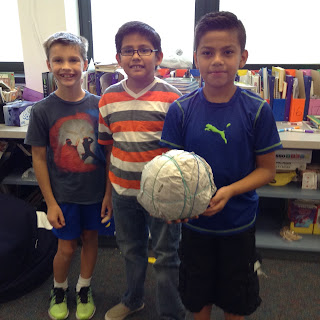As a part of our reading instruction, we read some books that included details about characters who were playing with soccer balls that they made out of available resources. We then connected this to our map skills unit for S.S., by researching how people around the world make soccer balls out of various odds and ends that are available. We plotted the countries on the map as we shared our information. We discussed the countries, continents, and hemispheres of each country and also discussed its proximity to the equator and the affect that has on climate. We found examples of makeshift soccer balls from Dubai, Brazil, Uganda, Kenya, Russia, and a few others. Through the course of this project, we also discovered that Pakistan manufactures a large portion of the world's soccer balls and Columbia manufactures many, as well. This research also helped us hone our researching skills, by using appropriate keywords, changing the focus of our research, and looking at all available resources in print and video.
Following this research, the kids were inspired to try and make their own makeshift soccer balls using some of the supplies found in our research. They formed groups based on the materials they were interested in using and designed their balls. During the design process, they listened to all group members' ideas and formulated a plan together. Once everyone was in agreement, they began constructing their balls. The engineering of the balls involved some adjustments and modifications to plans, as some of the original plans didn't work out the way they thought they would. Students had to problem solve through difficulties, use flexible thinking, and persevere through difficulties they encountered. They also had to learn to compromise, listen to each other, and make sure everyone in the group had a job. I'm so proud of the work that they've done so far! Here are some pictures of the process.
Following this research, the kids were inspired to try and make their own makeshift soccer balls using some of the supplies found in our research. They formed groups based on the materials they were interested in using and designed their balls. During the design process, they listened to all group members' ideas and formulated a plan together. Once everyone was in agreement, they began constructing their balls. The engineering of the balls involved some adjustments and modifications to plans, as some of the original plans didn't work out the way they thought they would. Students had to problem solve through difficulties, use flexible thinking, and persevere through difficulties they encountered. They also had to learn to compromise, listen to each other, and make sure everyone in the group had a job. I'm so proud of the work that they've done so far! Here are some pictures of the process.


























